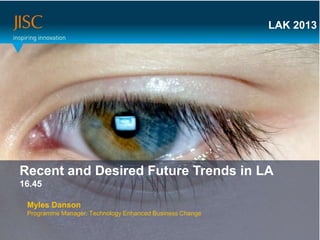Panel Session at Learning Analytics and Knowledge Conference 2013
- 1. LAK 2013 Presenter or main title… Recent and Desired Future Trends in LA Session Title or subtitle… 16.45 Myles Danson Programme Manager, Technology Enhanced Business Change
- 2. Jisc Myles and Sheila. What, Who?  Shared Service
- 3. Early Characteristics  New(ish) Field  Beacons of excellence  Narrow applications  Promise of great things  Little coordination of effort
- 4. Early Characteristics  Little evidence for business cases  Reliance on the implicit  More holes than net  New terminology  New roles  Intra community excitement  Extra community confusion
- 5. Current Opportunities  Early adopter opportunities and issues  Grass roots interventions  Nurturing  Peer support  Collaboration  Shared problem identification & solving  LAK 13, SOLAR, Educause, Jisc, SURF etc
- 6. The Challenge  A Cycle of innovation  Through to embedding
- 7. Business Intelligence (BI) comprises evidence-based decision- making and the processes that gather, present, and use that evidence base. It can extend from providing evidence to support potential students’ decisions whether or not to apply for a course, through evidence to support individual faculty and staff members, teams and departments, to evidence to support strategic decisions for the whole organisation. Analytics is the highest level of BI maturity - the process of developing actionable insights through problem definition and the application of statistical models and analysis against existing and/or simulated future data
- 8. Organisational Development  Utilise readiness / maturity frameworks  Organisations and Individuals  Work through representative bodies?  Shoot high (SMT, Policy, Governance)  Feed in the innovation
- 9. Project Reality (Austerity) Check  Beneficiaries – will your project benefit a sufficiently wide range of people  Reality of benefit delivery in the timescale  Reality of sustaining the outputs  Value to the sector  Innovativeness and benefits
- 10. Benefit Examples • Improved quality and reduced risk (anecdotal and quantitative)  Improved decision-making (anecdotal)  Better strategic planning (anecdotal)  Better risk management (anecdotal)  Competitive advantage (quantitative)  Income generation (quantitative)  Efficiency gains (quantitative)  Performance benchmarking (anecdotal and quantitative)  Student satisfaction (quantitative)  Student retention (quantitative)  League table ranking (quantitative)  Cash savings (e.g. from retired software, hardware, redeployed staff)  Income generation (quantitative)  Improved speed and efficiency (anecdotal and quantitative)
- 11. In Summary  Coordinate an innovation – embedding cycle  Focus on the benefits (which and to whom and how)  Co Design and partnerships (include vendors, stakeholder bodies)  Business case for investmen  Policy and governance  Organisational AND individual readiness issues  Keep up the grass routes innovation










